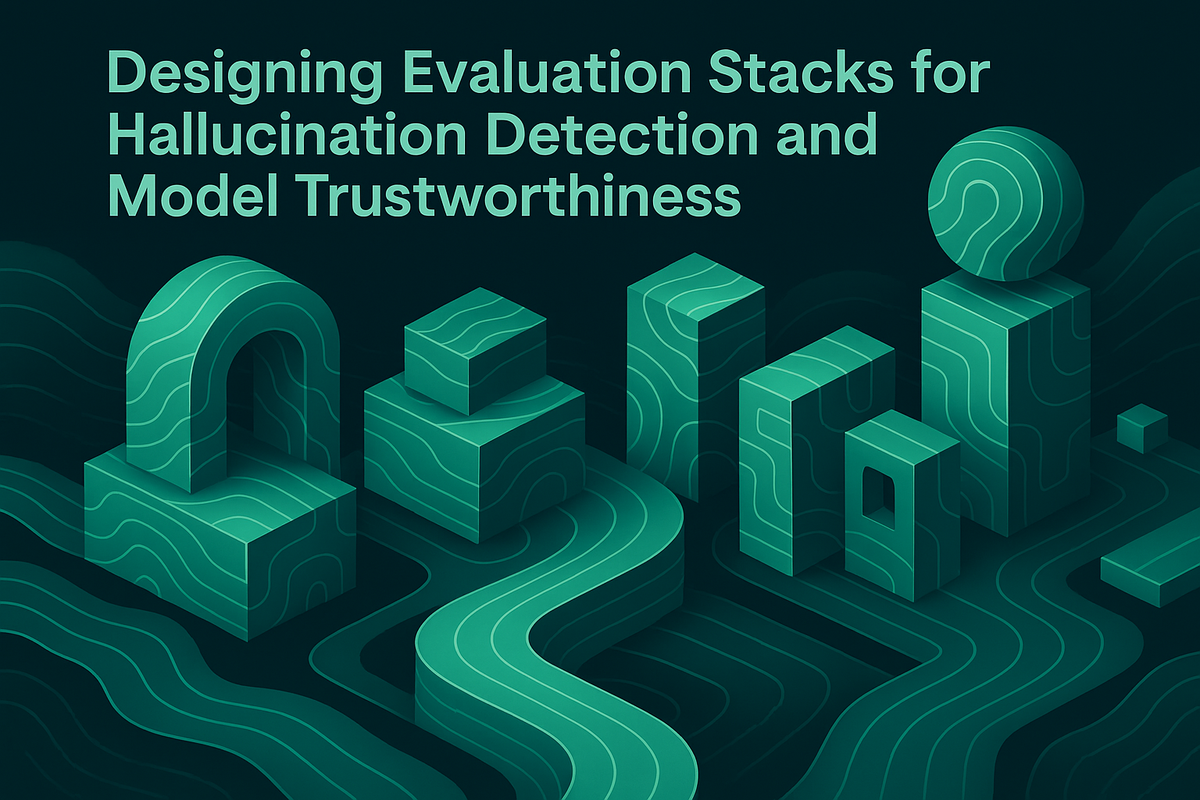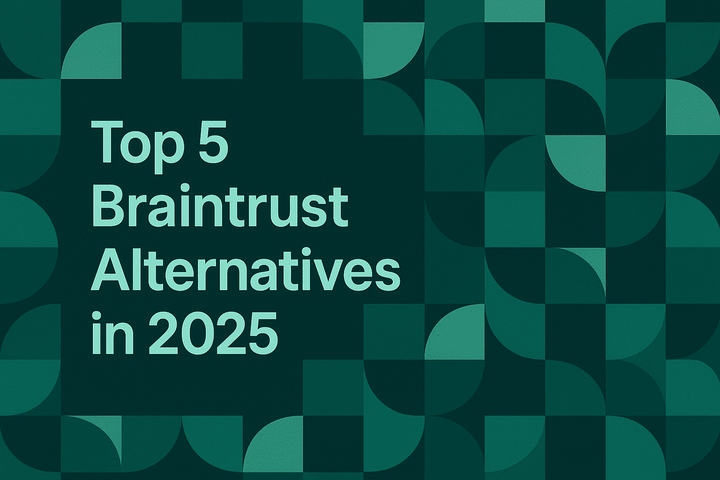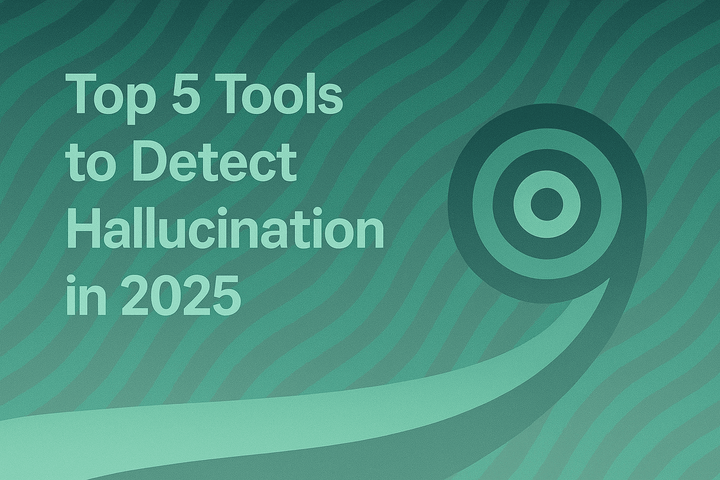Designing Evaluation Stacks for Hallucination Detection and Model Trustworthiness

TL;DR
Building trustworthy AI systems requires comprehensive evaluation frameworks that detect hallucinations and ensure model reliability across the entire lifecycle. A robust evaluation stack combines offline and online assessments, automated and human-in-the-loop methods, and multi-layered detection techniques spanning statistical, AI-based, and programmatic evaluators. Organizations deploying large language models need structured approaches that integrate hallucination detection, uncertainty quantification, and continuous monitoring to maintain production reliability and align with emerging trustworthiness standards.
Understanding Hallucinations and Their Impact on Model Trustworthiness
Hallucinations in large language models refer to instances where systems generate responses that appear coherent yet contain factually inaccurate information or unsubstantiated claims. These fabrications represent a critical challenge for AI trustworthiness, particularly in high-stakes domains like healthcare, legal services, and financial decision-making.
Detection methods for hallucinations broadly categorize into three groups: factual verification, summary consistency verification, and uncertainty-based hallucination detection. Each approach addresses different aspects of model reliability and requires specific implementation considerations within an evaluation stack.
Trustworthy AI extends beyond conventional performance metrics and requires rigorous evaluation across multiple dimensions, including fairness, transparency, privacy, and security throughout the design, development, and deployment phases. Organizations must consider how hallucinations undermine these dimensions and implement systematic detection frameworks.
The financial and reputational costs of unchecked hallucinations can be substantial. False outputs prevent adoption in diverse fields, with problems including fabrication of legal precedents or untrue facts in news articles, and even posing risks to human life in medical domains such as radiology. This makes hallucination detection not just a technical requirement but a business imperative.
Core Components of an Effective Evaluation Stack
Multi-Layered Detection Approaches
Previous studies have mainly concentrated on post-processing techniques for hallucination detection, which tend to be computationally intensive and limited in effectiveness due to their separation from the LLM's inference process. Modern evaluation stacks address this limitation through integrated, multi-layered approaches.
Uncertainty-Based Detection Methods
Research has developed entropy-based uncertainty estimators for LLMs that measure uncertainty about the meanings of generated responses rather than the text itself. This semantic approach provides more reliable hallucination signals than surface-level text analysis.
Uncertainty quantification methods categorize into self-supervised approaches like verbalized confidence and semantic entropy, along with trained methods that require labeled data. Organizations should implement both categories to balance computational efficiency with detection accuracy.
Internal State Analysis
Recent approaches analyze the internal attention kernel maps, hidden activations, and output prediction probabilities within LLM responses to detect hallucinations without requiring multiple model generations or external databases. These white-box methods offer real-time detection capabilities with minimal computational overhead.
Eigenvalue analysis of internal LLM representations helps highlight consistent patterns of modifications to hidden states and model attention across different token representations when hallucinations are present compared to grounded responses. This technique enables detection even in zero-resource scenarios.
Offline and Online Evaluation Integration
Evaluating LLM applications across their lifecycle requires a two-pronged approach: offline evaluation during pre-production using curated datasets, and online evaluation in production with real-time data. Effective evaluation stacks must seamlessly integrate both methodologies.
Offline Evaluation Components
Offline evaluation enables prompt validation and optimization before production deployment. Organizations should establish golden datasets that represent realistic user scenarios and edge cases. These datasets provide controlled benchmarks, offering clear pictures of how well the LLM application processes specific inputs and enabling engineers to debug issues before deployment.
Maxim's experimentation platform provides comprehensive capabilities for offline evaluation, including prompt versioning, multi-model comparison, and systematic testing across different configurations. Teams can iterate rapidly on prompt engineering while measuring quality, cost, and latency trade-offs.
Online Evaluation Components
Online evaluation takes place in real-time during production, where applications interact with live data and real users, providing essential feedback about behavior under dynamic, unpredictable conditions. This requires continuous monitoring systems with automated alerting.
Effective LLM evaluation frameworks include metrics to characterize both prompts and responses, as well as internal inputs and outputs in agentic or chain-based LLM applications, for insights into application performance across multiple dimensions. Maxim's observability suite enables comprehensive tracking and debugging with real-time alerts for production issues.
Comprehensive Evaluator Library
A production-grade evaluation stack requires diverse evaluator types addressing different quality dimensions:
AI-Based Evaluators
AI evaluators leverage language models themselves to assess output quality. Maxim provides pre-built evaluators including:
- Faithfulness evaluation to ensure generated content remains grounded in provided context
- Context relevance assessment to verify retrieved information appropriately addresses queries
- Clarity and conciseness metrics to measure output understandability
- Toxicity detection to identify harmful content
Statistical Evaluators
Statistical metrics like BLEU, ROUGE, and semantic similarity provide quantitative measures for text quality and factual overlap with reference materials. Maxim's evaluation stack includes semantic similarity metrics and embedding distance measures like cosine distance for quantitative quality assessment.
Programmatic Evaluators
Deterministic checks validate structural and formatting requirements. Maxim provides programmatic evaluators for JSON validation, email format verification, and other rule-based quality gates.
Organizations can also implement custom evaluators tailored to domain-specific requirements, ensuring evaluation frameworks address unique application needs.
Building Production-Grade Evaluation Workflows
Dataset Curation and Management
Quality evaluation depends on representative datasets. Best practices include evaluating the LLM application using pre-designed questions across different responsible AI categories, including fairness, safety, and accuracy considerations.
Maxim's data engine enables teams to:
- Import multi-modal datasets including images and structured data
- Continuously curate datasets from production logs
- Enrich data through human annotation and feedback loops
- Create targeted data splits for specific evaluation scenarios
Evaluation effectiveness varies significantly based on dataset characteristics, with methods performing differently across applications involving large amounts of context, numerical data, or complete sentence structures. Teams should develop diverse test suites covering expected production scenarios.
Simulation and Agent Testing
Uncertainty quantification methods face limitations when applied to interactive and open-ended agent systems, where task-underspecification and context-underspecification uncertainties arise from unclear prompts or missing essential information. This necessitates specialized evaluation approaches for agentic systems.
Maxim's simulation platform enables comprehensive agent testing through:
- AI-powered simulations across hundreds of scenarios and user personas
- Conversational-level evaluation analyzing complete agent trajectories
- Task completion assessment identifying points of failure
- Step-wise re-simulation for debugging and root cause analysis
Voice simulation capabilities extend evaluation to voice-based agents, ensuring multimodal applications maintain quality across interaction modalities.
Human-in-the-Loop Validation
Despite progress in automated metrics, evaluation for LLMs remains somewhat subjective, making human evaluation a valuable source of insights into model response quality. Automated evaluations should be complemented with human oversight for nuanced quality assessment.
Maxim provides human annotation workflows for last-mile quality checks. Teams can:
- Define custom annotation schemas for domain-specific criteria
- Collect human feedback on production outputs
- Integrate human judgments into continuous improvement cycles
- Establish ground truth datasets for evaluator calibration
When monitoring LLM applications in production, leveraging user experience data from inputs and outputs enables cheaper heuristics that signal when applications produce incorrect outputs or stray from response guardrails. Maxim's user feedback collection integrates directly into production monitoring workflows.
Implementing Maxim's End-to-End Evaluation Stack
Unified Platform Advantages
Organizations evaluating hallucination detection platforms should prioritize end-to-end capabilities spanning experimentation, evaluation, simulation, and observability. Fragmented toolchains create integration overhead and limit cross-functional collaboration.
Maxim provides a comprehensive platform where:
- AI engineers conduct technical evaluations using SDK-based workflows
- Product teams configure evaluations without code through intuitive UI
- Cross-functional stakeholders access custom dashboards with insights across relevant dimensions
- Evaluation results inform both pre-production optimization and production monitoring
Prompt Management and Deployment
Prompt management capabilities enable version control, deployment strategies, and systematic testing. Teams can:
- Organize prompts with folders and tags for easy discovery
- Compare prompt versions across quality and performance metrics
- Deploy prompts with experimentation strategies like A/B testing
- Integrate prompt updates into CI/CD pipelines
RAG and Retrieval Evaluation
For retrieval-augmented generation systems, Maxim provides specialized evaluators assessing:
- Context precision measuring relevant information density
- Context recall evaluating retrieval completeness
- Faithfulness metrics ensuring generated responses align with retrieved context
These evaluators address the unique challenges of RAG architectures where hallucinations can occur during both retrieval and generation phases.
Production Monitoring and Alerting
Applications deployed in production environments need constant monitoring to detect issues such as degradation in performance, increased latency, or undesirable outputs including hallucinations and toxicity.
Maxim's observability infrastructure provides:
- Distributed tracing capabilities capturing complete request flows
- Automated evaluation on logs running quality checks continuously
- Alerts and notifications for quality threshold breaches
- Performance analytics tracking latency, token usage, and costs
Teams can configure node-level evaluation for granular quality assessment across multi-step agent workflows.
Integration with AI Gateways
Maxim's Bifrost AI gateway provides additional infrastructure for trustworthy AI deployment:
- Unified interface across 12+ LLM providers enabling rapid provider switching
- Automatic fallbacks maintaining service availability during provider issues
- Semantic caching reducing costs and latency while improving consistency
- Governance features including budget management and usage tracking
This gateway layer complements evaluation workflows by providing infrastructure-level reliability and observability across provider boundaries.
Establishing Trustworthiness Standards
Alignment with Regulatory Frameworks
The NIST AI Risk Management Framework is intended for voluntary use to improve the ability to incorporate trustworthiness considerations into the design, development, use, and evaluation of AI products, services, and systems. Organizations should align evaluation practices with established frameworks.
Trustworthiness evaluation requires systematic measurement across the AI lifecycle stages, addressing trade-offs when optimizing for different trustworthiness dimensions including fairness, transparency, and security. Evaluation stacks should support multi-dimensional quality assessment.
Key regulatory considerations include:
- The OECD AI Principles representing the first intergovernmental standards for AI with 47 adherents worldwide
- European Union guidelines emphasizing human-centric AI development
- GDPR compliance for data privacy in AI systems
- Industry-specific regulations in healthcare, finance, and other sectors
Documentation and Transparency
Before deploying an LLM, comprehensive evaluation should document model limitations and sources of bias, developing techniques like human feedback loops to minimize unsafe behavior. Transparency creates accountability essential for responsible AI.
Maxim's platform supports documentation through:
- Prompt sessions capturing development histories
- Evaluation run reports comparing model versions
- Production trace exports for audit and compliance
- Structured metadata and tagging for discoverability
Organizations should establish processes ensuring evaluation findings inform both technical improvements and stakeholder communication about model capabilities and limitations.
Continuous Improvement Cycles
Trustworthiness must be considered at every phase of the system lifecycle, including sale and deployment, updates, maintenance, and integration. Evaluation workflows should enable continuous optimization.
Best practices for continuous improvement include:
- Regular dataset refreshes incorporating new production scenarios
- Periodic evaluator calibration against human judgments
- A/B testing for prompt and model changes using real user traffic
- Feedback loop integration capturing edge cases for dataset augmentation
Maxim's platform facilitates these cycles through integrated workflows connecting evaluation insights to development iterations. Teams can quickly curate datasets from logs, run evaluations, and deploy improvements systematically.
Conclusion
Designing effective evaluation stacks for hallucination detection and model trustworthiness requires comprehensive approaches integrating multiple detection methodologies, evaluation types, and lifecycle phases. Organizations cannot rely on single-point solutions but must build systematic frameworks addressing the complexity of modern AI systems.
The key principles for successful evaluation stacks include:
- Multi-layered detection: Combining uncertainty quantification, internal state analysis, and retrieval verification
- Lifecycle integration: Seamless workflows spanning offline development through online production monitoring
- Diverse evaluators: AI-based, statistical, and programmatic methods addressing different quality dimensions
- Human oversight: Structured annotation and feedback complementing automated assessments
- Continuous improvement: Systematic processes translating evaluation insights into iterative enhancements
Maxim provides an end-to-end platform implementing these principles, enabling organizations to build, evaluate, and deploy trustworthy AI systems with confidence. The unified approach accelerates development velocity while maintaining rigorous quality standards across the entire AI lifecycle.
As language models continue advancing in capability and adoption, evaluation infrastructure becomes increasingly critical for successful deployment. Organizations investing in robust evaluation stacks position themselves to realize AI's potential benefits while managing inherent risks through systematic quality assurance.
Get started with Maxim to implement comprehensive evaluation workflows for hallucination detection and model trustworthiness across your AI applications.


